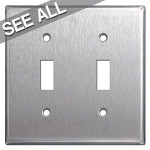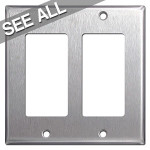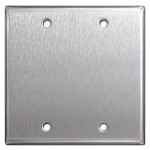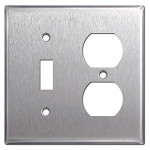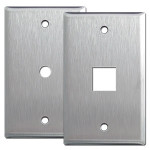What switch color looks best with 302/304 stainless steel cover plates?
The most popular colors for electrical devices used with this finish are white, gray, and black. Having trouble choosing? Look around your building and take notice of the surrounding paint colors, countertops, and appliances to help you decide. If you simply prefer that the switches and outlets remain as unnoticeable as possible, choose neutral gray switches and receptacles for your application.
Switches for Brushed Stainless Plates
Why choose 302 stainless steel over 430 stainless steel wallplates? What is the difference?
302/304 is specification grade steel, while 430 is residential grade. While both are made of .030" steel, 302 stainless steel has a greater corrosion resistance than regular 430 stainless steel. It is also a non-magnetic metal and is used in a variety of commercial and industrial applications and anywhere food or beverages are served or sanitation is a concern. It is recommended for its good mechanical properties and in some places is required by law to pass inspections. 302/304 spec grade stainless steel switch cover plates are the professional choice for government offices, utilities, and other facilities that must meet federal fire and safety requirements. 430 stainless steel switch plates are a good choice for residential use.
Which is more popular - 302/304 stainless steel or 430 stainless steel?
The 430 stainless steel wall plates are more generally more popular because they are available in a larger number of sizes and are slightly less expensive. Unless you prefer the specialized properties of 302 stainless steel (non-magnetic for equipment, resists corrosive chemicals, specification grade) or it is required per the job specs, you probably don't need to upgrade to this finish.
What direction is the brushing on 302/304 stainless steel wall plates?
One and two gang plates are vertically grained; three gang plates and larger have a horizontal grain. Satin brush finishes help hide fingerprints.
Is there a difference between satin and brushed stainless steel wall plates?
Technically the stainless steel wall plates have a satin surface but the terms are used interchangeably depending upon the manufacturer of plumbing fixtures, hardware, and appliances. Both 430 stainless steel and 302/304 stainless steel light switch plates have the same obvious grain pattern and a medium degree of texturing that we usually refer to as a brushed satin finish - not highly brushed but not subtle either - that coordinates well with stainless steel appliances and fixtures.
What color are 302/304 stainless steel wall plates? Are they the same color as regular 430 stainless steel?
Stainless steel color and finish is in between satin nickel and satin chrome finishes. 302 Stainless steel plates are a slightly warmer silvery-gray color than 430 stainless steel wall plates. Good match with brushed nickel finish faucets and fixtures.
What is the metal composition of 302 stainless steel?
These type 304 stainless steel (US Bureau Standards Symbol #32D) are made up of iron, 18% chrome and 8% nickel. Meets all UL standards. Clean with a soft cloth using dusting spray and avoid cleansers.
Will stainless steel wall plates show fingerprints?
As is the case with any stainless steel kitchen appliance, the wall plates can show fingerprint smudges.
Clean our 302 steel covers with dusting spray and a soft cloth to remove any lingering fingerprints.
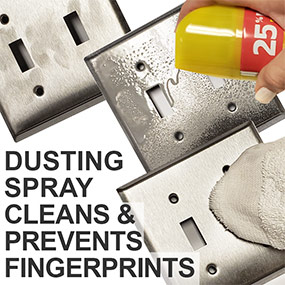
Other methods for cleaning stainless steel include mild soap & water, white or apple cider vinegar, a dab of olive or baby oil, or a streak-free glass cleaner.
Always scrub in the direction of the steel grain to avoid scratches.
For especially tricky stains, pour the cleaning agent on the plate and let it sit a few minutes before scrubbing with a soft cloth. Also scrub in the same direction as the grain of the steel.
To fix any discolored spots or dark stains, use baking soda with white vinegar. Pour baking soda onto the stain followed by a small amount of vinegar. Once it bubbles, rub the plate with a soft cloth (in the same direction as the natural grain). Afterward, rinse the plate with a damp paper towel or soft cloth.
Can I incorporate 304/302 stainless steel cover plates in my nautical themed bedroom?
Definitely. 302 stainless steel wall switchplates can be used in a variety of decorating designs including, but not limited to, Contemporary, Scandinavian, and Modern styles. Stainless steel's cool coloring will coordinate well with the blues and grays often found in nautical inspired decor.
I'd like to install these switch covers in my kitchen, would they do well in that environment?
Yes. These switch plate covers are suitable for every room including your bathroom, garage, bedroom, dining room, in-home office, social room and entryway.
I live near the coast. Which stainless finish should I choose?
The 302 stainless steel would be the recommended finish inside homes or businesses exposed to salty air.
Would 302 stainless steel switchplates be suitable for my office?
Yes, our 302 stainless steel collection is meant to be used in various commercial spaces such as industrial warehouses, studios, and gyms.
Types of Stainless Steels
There are three main types of stainless steel determined by their microstructure or predominant crystal phase: Austenitic, Ferritic and Martensitic. Austenitic steels have face centered cubic crystals or "austenite" as their main phase and include type 302 and type 304 stainless steel. Ferritic steels have body centered cubic crystals or "ferrite" as their main phase and include type 430. Martensitic steels are low carbon steels with a type 410 composition.
304/302 Stainless Steel Corrosion Resistance and Hardness
The common name for 302 stainless is Chromium-Nickel steel. Type 302 stainless steel has the same corrosion resistance as 304 stainless steel but with slightly higher strength due to additional carbon. It is commonly used in wire and strip form. When the alloy type and grade are not specified, stainless steel is called corrosion-resistant steel or CRES.
302/304 Stainless Steel Composition and Properties
Adding a minimum of 12% chromium to the steel makes it resist rust more than other types of steel. Chromium in the steel combines with atmospheric oxygen to form a thin, invisible layer of chrome-containing oxide, called the passive film. Stainless steel does not stain, rust or corrode as easily as ordinary steel, in other words it stains less, however it is not stain-proof.
Type 302 stainless steel has a composition of iron, 18% chromium, and 8% nickel and is a slightly higher carbon form of type 304 stainless. Austenitic steels such as type 302 or type 304 can not hardened by heat treatment. Type 304 surgical stainless steel contains iron, 18-20% chromium and 8-10% nickel.
Ferritic steels such as type 430 stainless steel have a composition of 17% chromium. Ferritic steel is less ductile than austenitic steel and cannot be hardened by heat treatment. Martensitic steels are composed of iron, 12% chromium, and 0.12% carbon. They can be tempered and greatly hardened, but this reduces its toughness and makes it brittle. Few steels are fully hardened for this reason.

